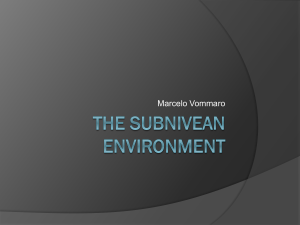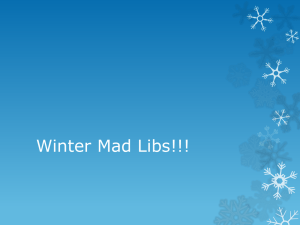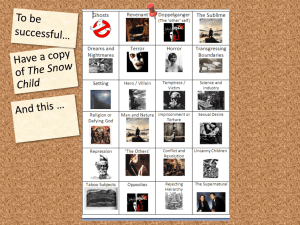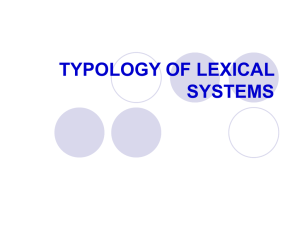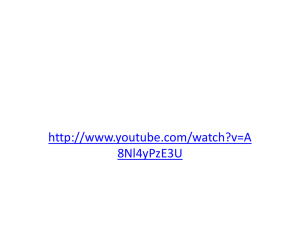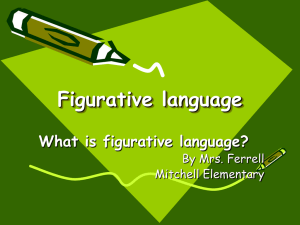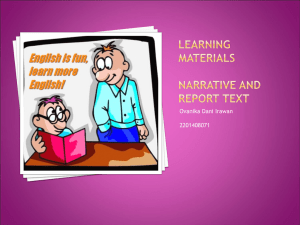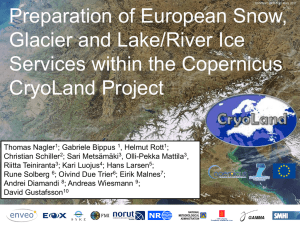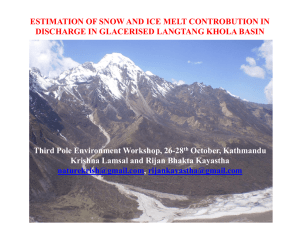A Composite Study of Snow Squa
advertisement
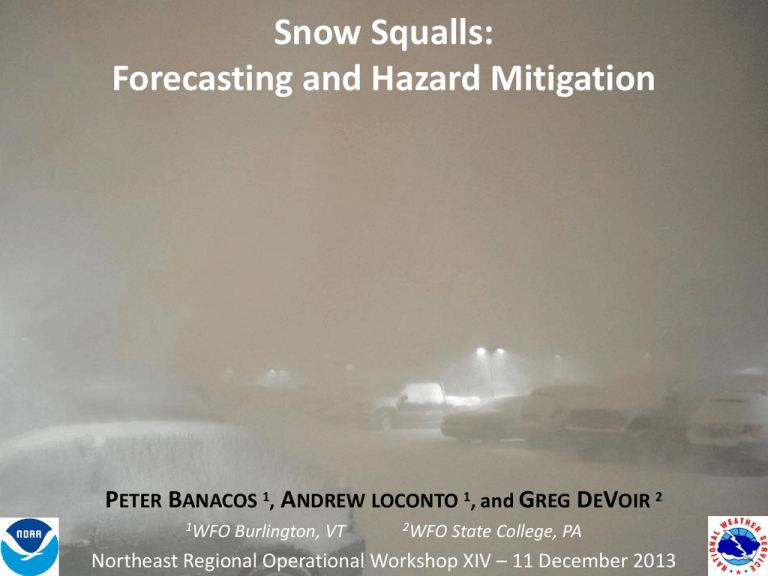
Snow Squalls: Forecasting and Hazard Mitigation PETER BANACOS 1, ANDREW LOCONTO 1, and GREG DEVOIR 2 1WFO Burlington, VT 2WFO State College, PA Northeast Regional Operational Workshop XIV – 11 December 2013 Outline Background information on squalls and societal impacts Synoptic and mesoscale snow squall environments Snow Squall Forecasting Parameter R20: Research Operations Conveying the message (Special Wx Statements, Social Media, Interactive Highway signs, action plans, etc.) 2 What is a Snow Squall? A mesoscale convective system producing gusty winds & heavy snow. • • • • Tend to be short-lived Don’t reach NWS snow advisory criteria Falling temperatures can produce a “flash freeze” situation Can have deadly road consequences (high-impact, sub-advisory, HISA) Time-Matched Imagery 30 November 2007 Elm St., Potsdam, NY TYX 0.5o reflectivity loop 3 Long history of deadly accidents with snow squalls (~ 1”)… NBC33 - Indianapolis …how do we mitigate this? Burlington Free Press 4 PREVIOUS STUDIES OF SNOW SQUALLS (non-lake effect) • A few case studies and one forecast technique (WINDEX, Lundstedt 1993). • Cool-season MCS work may be relevant (e.g., Low-Dewpoint MCS/derechos, Corfidi et al. ‘06). • Some focus on external partnerships (Devoir 2004, NWS – PENNDOT) WHAT WE WANT TO DO: Create a snow squall database and improve our meteorological understanding through compositing Improve forecaster situational awareness by developing a new snow squall parameter (these are low QPF events) Validate snow squall parameter against individual cases Continue to improve operational messaging, education, and state/local partnerships END RESULT: More certainty in forecast products, better lead times. Better communication. Road crews pre-treat surfaces 5 Creating a Snow Squall Database MSS BTV MPV New York Vermont METHODS • Searched 10 years of ASOS data for moderate or heavy snow (VSBY ≤ ½ SM) with a west wind component. • Each S or S+ observation was compared with 2-km radar mosaics to subjectively determine if the event was associated with a cold front or mobile upper trough (and not a stratiform/WAA case). • Found 36 total snow squall events (2001-02 through 2010-11). 3 ASOS locations used • Logged surface data characteristics for each case. 6 Surface and Synoptic Features 7 Snow squalls are short-lived events… ASOS VSBY ≤ ¼ SM VSBY ≤ ½ SM 8 Modest Snow Amounts Small Liquid Equivalent Continental SLRs 9 Dendrite growth zone (-12 to -18C) Wind speed max (38 kts) 𝜕𝜃𝑒 < 0𝜕 𝜕𝑧 Potential instability 10 BUFKIT Summary • Time-height cross-sections: – A brief, intense zone of UVV in the lowest 2km AGL. • Intersects Dendritic Growth Zone (-12 to -18C) in saturated (RH ≥ 90%) atmosphere • Along/just ahead of cold front. – Examine θe profile for vertically-oriented or folded isentropes (steep lapse rates, potential instability). – Well-defined wind shift with strongest wind speeds/ mixing just behind front. – Don’t get hung up on QPF. Likely only ~0.05”. 11 Parameters Examined using 3-hrly NARR data in GEMPAK (analysis times immediately before and after squall time) SBCAPE MUCAPE (0-180mb) Sfc-2km Theta-e difference Sfc-2km RH Sfc-2km mean wind Sfc-2km wind shear 925mb frontogenesis Sfc isallobars (3hrly) 850mb frontogenesis WBZ height Precipitable Water 300mb Divergence 925mb theta-e Adv. 850mb theta-e Adv. 850mb temperature advection 0-2km lapse rate 12 NARR Variable Distribution for 36 Snow Squall Events Normalized between 25th and 50th percentile values… 9ms-1, 75%, 0K/2km 13 NARR SCATTERPLOT of 0-2km mean RH vs. THETA-E Difference (36 SNSQ CASES) Favored parameter space 14 Necessary Ingredients for Squalls Moist convection, but cold enough for snow. (1) moisture, (2) lift, (3) instability, (4) wind, and (5) vertical temperature structure (to support snow) Snow Squall Parameter (SNSQ, non-dimensional) plot only for values > 0 and where Tw ≤ 1 C @ 2m Moisture Cold enough for snow low-level Instability Wind Calibration was done using NARR data, but can be tweaked for operational models. SNSQ approaches zero as any of these variables approaches zero. Lift (forcing) would be assessed independently (isallobaric rise/fall couplet, F-GEN). 15 2005-06 Winter SNSQ Parameter One # to highlight where kinematic and thermodynamic conditions are favorable for snow squalls. 3-hrly NARR SNSQ time series at BTV (5 months) Case Examples • 11-12 February 2003 (using the NARR) • 17 January 2013 (using the NARR & BTV-12km WRF) BTV-12km WRF: Initialized with the GFS and no convective parameterization. 17 Testing the SNSQ Parameter Against Past Events: 11-12 Feb 2003 “SNOW DERECHO” CASE EXAMPLE 1 18 CG Lightning (11/20z through 12/12z) 11-12 Feb 2003 RADAR WI SNSQ Parameter SNSQ 21z Shaded, left panels 11/21 Z 3-hr Isallobars WI A simple way to assess convergence (lift) /propagation 12/00 Z 00z WI 12/03 Z 03z Pres. couplets often the difference between convective snow showers and organized squalls 19 0-2km qe Diff. 0-2km Mean RH (%) Isallobaric Convergence 3-hr Isallobars (mb) 925mb F-gen SBCAPE (J kg-1), 925mb Frontogenesis (K 100km-1 3hr-1) 20 16-17 January 2013 EXAMPLE 2 SNSQ (03z, 9 h forecast) BTV-12km WRF 17 Jan 2013 Intense snow squalls along sharp cold front Lake effect snow showers 21 SNOW SQUALL OBSERVATIONS: CYYU 161900Z 33020KT 1/8SM +SN +BLSN VV001 M14/M35 A2944 RMK SN8 PRESRR SLP962 CYNM 162300Z AUTO 33028G37KT 1/4SM +SN BLSN VV005 M17/M19 A2936 RMK MAX WND 33037KT AT 2300Z PRESRR SLP968 17/0040Z CYXR 162354Z AUTO 32028G38KT 230V330 1/8SM +SN SCT014 BKN019 BKN027 OVC070 M08/M10 A2948 RMK MAX WND 27038KT AT 2345Z PRESRR SLP998 Reflectivity – Landrienne, Quebec 16-17 January 2013 Case EXAMPLE 2 CYSB 170146Z 35021G28KT 1/2SM R22/2800VP6000FT/D SHSN DRSN VV003 RMK SN8 CYVO 170148Z 32020G28KT 1/2SM -SN BLSN VV007 M14/M15 A2951 RESN RMK BLSN8 PRESRR SLP022 22 NARR SNSQ parameter with PMSL and isallobars (03z 17 Jan 2013) SNSQ isallobaric wind Convergence maximized on leading edge of isallobaric gradient (usually near zero change line). 23 Isallobaric Convergence Isallobaric convergence part of thermally direct frontogenetic circulation. 925mb F-gen 24 SNSQ Parameter (17/12z) (BTV-12km WRF 12-hr FCST) View from Burlington, VT of snow squall crossing Lake Champlain (17/13z) Mosaic Composite Reflectivity (17/1155z) See the SNSQ Parameter in Real-Time SNSQ On the Web (BTV 4 and 12km WRF runs) URLs: http://www.erh.noaa.gov/btv/html/4kmwrf/index.php http://www.erh.noaa.gov/btv/html/12kmwrf/index.php AWIPS 4-panel procedures (Volume browser changes sent to the SOO mail list) SPC is working on adding the SNSQ Parameter to Mesoanalysis page (full CONUS availabiliity) 26 QUESTIONS? E-MAIL peter.banacos@noaa.gov, andrew.n.loconto@noaa.gov, greg.devoir@noaa.gov 27


